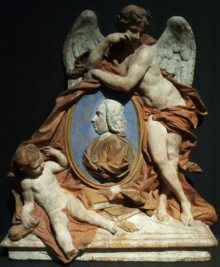Manuel Pereira de Sampaio
Manuel Pereira de Sampaio (Lagos; 1692 - Rome; February 1750) was a Portuguese nobleman and diplomat, who served as King John V of Portugal's ambassador to the Holy See.
Manuel Pereira de Sampaio | |
|---|---|
 Funerary monument to Manuel Pereira de Sampaio, designed by Filippo della Valle for Sant'Antonio dei Portoghesi (located in the Museu Nacional de Arte Antiga). | |
| Portuguese Ambassador to the Holy See | |
| In office 1740–1750 | |
| Monarch | John V of Portugal |
| Preceded by | José Maria da Fonseca de Évora |
| Succeeded by | António Cabral |
| Personal details | |
| Born | 1692 Lagos, Kingdom of the Algarve |
| Died | February 1750 Civitavecchia, Papal States |
He is remembered notably for having secured the styling of Most Faithful Majesty for the Portuguese monarchy, in 1748, and for compiling what is now known as the Weale Album (Portuguese: Álbum Weale), an extensive catalog of artistic commissions by John V for Lisbon from Rome.
Life
The exact details of his origins are unclear, it is known that Pereira de Sampaio was born in Lagos, in the Algarve, as a bastard of a minor Fidalgo of Portuguese nobility.
He was governor of the Church of Sant'Antonio dei Portoghesi, the Portuguese national church in Rome, and a prominent member of the artistic scene in Rome at the time. His position as governor, his personal reports on Pope Benedict XIV to King John V, and his close relationship with João Baptista Carbone, personal secretary of the Portuguese king, were all deciding factors in his nomination as ambassador to the papal court.[1]
While ambassador, Pereira de Sampaio cataloged the numerous artistic commissions made by King John V in Rome, including artwork destined for Ribeira Palace and the famed Chapel of St. John the Baptist, destined for the Igreja de São Roque, in what is now known as the Weale Album.
In 1748, Pereira de Sampaio achieved what is considered as the high point of his career, the granting of the style Most Faithful Majesty, by Pope Benedict XIV to King John V.
Pereira de Sampaio died in February 1750, in Civitavecchia, of an asthma attack, while preparing for an expedition back to Lisbon with works of art destined for the Patriarchal Basilica in Lisbon. He is buried in Sant'Antonio dei Portoghesi with a funerary monument dedicated to him designed by Filippo Della Valle.[2]
References
- Canelas, Lucinda (23 July 2015). "Este álbum de desenhos é uma viagem e uma declaração de inocência". Público. Retrieved 1 November 2015.
- Vale, Teresa Leonor (2006). "Obras do escultor Filippo della Valle (Florença, 1698 – Roma, 1768) realizadas para Portugal ou para portugueses" (PDF). Revista da Faculdade de Letras - CIÊNCIAS E TÉCNICAS DO PATRIMÓNIO. I. pp. 601–614. Retrieved 1 November 2015.